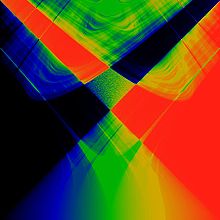
Back زبانه آرنولد FA לשון ארנולד HE アーノルドの舌 Japanese Языки Арнольда Russian Відображення кола Ukrainian

In mathematics, particularly in dynamical systems, Arnold tongues (named after Vladimir Arnold)[1][2] are a pictorial phenomenon that occur when visualizing how the rotation number of a dynamical system, or other related invariant property thereof, changes according to two or more of its parameters. The regions of constant rotation number have been observed, for some dynamical systems, to form geometric shapes that resemble tongues, in which case they are called Arnold tongues.[3]
Arnold tongues are observed in a large variety of natural phenomena that involve oscillating quantities, such as concentration of enzymes and substrates in biological processes[4] and cardiac electric waves. Sometimes the frequency of oscillation depends on, or is constrained (i.e., phase-locked or mode-locked, in some contexts) based on some quantity, and it is often of interest to study this relation. For instance, the outset of a tumor triggers in the area a series of substance (mainly proteins) oscillations that interact with each other; simulations show that these interactions cause Arnold tongues to appear, that is, the frequency of some oscillations constrain the others, and this can be used to control tumor growth.[3]
Other examples where Arnold tongues can be found include the inharmonicity of musical instruments, orbital resonance and tidal locking of orbiting moons, mode-locking in fiber optics and phase-locked loops and other electronic oscillators, as well as in cardiac rhythms, heart arrhythmias and cell cycle.[5]
One of the simplest physical models that exhibits mode-locking consists of two rotating disks connected by a weak spring. One disk is allowed to spin freely, and the other is driven by a motor. Mode locking occurs when the freely-spinning disk turns at a frequency that is a rational multiple of that of the driven rotator.
The simplest mathematical model that exhibits mode-locking is the circle map, which attempts to capture the motion of the spinning disks at discrete time intervals.
- ^ Arnol'd, V.I. (1961). "Small denominators. I. Mapping the circle onto itself". Izvestiya Rossiiskoi Akademii Nauk. Seriya Matematicheskaya. 25 (1): 21–86. Section 12 in page 78 has a figure showing Arnold tongues.
- ^ Translation to english of Arnold's paper: S. Adjan; V. I. Arnol'd; S. P. Demuškin; Ju. S. Gurevič; S. S. Kemhadze; N. I. Klimov; Ju. V. Linnik; A. V. Malyšev; P. S. Novikov; D. A. Suprunenko; V. A. Tartakovskiĭ; V. Tašbaev. Eleven Papers on Number Theory, Algebra and Functions of a Complex Variable. Vol. 46. American Mathematical Society Translations Series 2.
- ^ a b Jensen, M.H.; Krishna, S. (2012). "Inducing phase-locking and chaos in cellular oscillators by modulating the driving stimuli". FEBS Letters. 586 (11): 1664–1668. arXiv:1112.6093. doi:10.1016/j.febslet.2012.04.044. PMID 22673576. S2CID 2959093.
- ^ Gérard, C.; Goldbeter, A. (2012). "The cell cycle is a limit cycle". Mathematical Modelling of Natural Phenomena. 7 (6): 126–166. doi:10.1051/mmnp/20127607.
- ^ Nakao, M.; Enkhkhudulmur, T.E.; Katayama, N.; Karashima, A. (2014). Entrainability of cell cycle oscillator models with exponential growth of cell mass. Conference of Engineering in Medicine and Biology Society. IEEE. pp. 6826–6829.